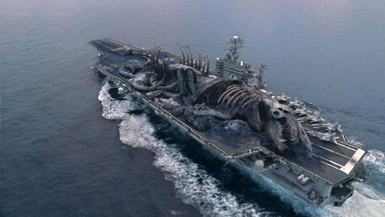Movie Review: Pacific Rim
By Matthew Huntley
July 16, 2013
If there’s anything worth taking away from Guillermo del Toro’s Pacific Rim, it’s the special effects. They are top-notch and exceptional, blending seamlessly with their practical surroundings and the human actors in front of them. Any time a Kaiju (the Japanese word for “beast”) or Jaeger (the German word for “hunter”) appeared on-screen, I was convinced these two elephantine creatures were really there, duking it out in the ocean or in the world’s most populous cities. And since the movie’s primary objective seems to be bringing these entities to life, it’s all the more imperative they look credible. For anyone craving an effects-laden summer actioner, Pacific Rim is your movie.
On the other hand, for those of us desiring anything more than a technical exercise, Pacific Rim proves to be a disappointment. Despite the context under which I was seeing it - the summer blockbuster season, a time when movies of this type are meant to thrive and function as “mindless fun” - I walked away unfulfilled, which was even more shocking considering del Toro (the Hellboy films, Pan’s Labyrinth) was in the director’s chair. A “mindless” movie-going experience can often be fun, but it isn’t necessarily impervious to being “derivative,” “uninspiring,” “lackadaisical” or just plain “bad,” and these are a few words I’d use to describe some things in Del Toro’s movie that weren’t digitally rendered.
What’s most disheartening is underneath all the movie’s negative qualities is del Toro’s ceaseless enthusiasm. His fervent energy pulsates throughout every scene and we can imagine how giddy he must have been making a monster movie of this magnitude, like a kid in a candy store (or in del Toro’s case, a born filmmaker in a movie studio with everything you can imagine at his disposal). The problem is that it gets overshadowed by a secondhand story, one-dimensional characters and often goofy, laughable dialogue, even for a summer blockbuster. These were things I simply couldn’t tune out, even though I wish I could.
The movie takes place in the not-too-distant future, after mankind learns the hard way a portal has opened up deep beneath the Pacific Ocean, serving as a bridge between our world and the world of the Kaiju, a race of huge, horrific-looking monsters with limited intelligence and an overt tendency to eat, yelp, and go on destructive rampages, à la Godzilla. Our first encounter with one of the beasts ends with six cities getting destroyed, before we finally take it down with traditional tanks and bombs. To prepare ourselves for future Kaiju attacks, the world’s nations unite and develop Jaegers, which are equally large, humanoid machines (think Transformers) controlled by two pilots linked in a neural drift. The pilots exchange everything down to their deepest, darkest memories so they’re in perfect sync to control the Jaeger.
For a while, the Jaeger program proves successful and humans are able to put up a decent fight, so much that the Kaiju battles become somewhat routine and glorified, going so far as to generate a thriving commercial industry with reality shows and action figures. But “then everything changed,” according to Raleigh Beckett (Charlie Hunnam), a young, reckless soldier who pilots a Jaeger with his older brother Yancy (Diego Klattenoff). During what would have been a standard mission to destroy a Kaiju approaching a nearby city, the two brothers disobey a director order from their commanding officer, Stacker Pentecost (Idris Elba), and the ordeal ends tragically with Yancy’s death.
Continued:
1
2
|
|
|
|




